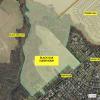Connecting the dots: Rehoboth and Selbyville post offices
Last week’s column about the Karl Knaths mural in the Rehoboth Beach Post Office led me this week to the Selbyville Post Office to view another mural of the same vintage.
Before I even walked through the front door in Selbyville, another immediate connection caught my eye. The architecture of the Selbyville Post Office is remarkably similar to that of Rehoboth’s Post Office.
The Cape Gazette recently published a historic photo postcard showing the Rehoboth Post Office as it appeared in 1940, just a few years after its completion. One prominent structural feature that is now gone is the decorative cupola that originally adorned the top of the building.
In Selbyville, the cupola remains. A photograph of the Selbyville Post Office accompanies this column at capegazette.com.
The similarity of the two buildings’ architecture is no coincidence. The buildings, and the original artworks in their lobbies, are all products of President Franklin Delano Roosevelt’s New Deal initiative designed to address high unemployment and the economic ravages caused by the Great Depression in the early 1930s.
LivingNewDeal.org chronicles those thousands of projects across the nation and explains the programs with these words: “Over the decade 1933-43, a constellation of federally sponsored programs put millions of jobless Americans back to work and helped to revive a moribund economy. The result was a rich landscape of public works across the nation, often of outstanding beauty, utility and craftsmanship – all built to serve civic purposes.”
Although the Biden administration’s American Rescue Plan features a pandemic component that wasn’t part of Roosevelt’s New Deal, the aims of the two programs ring with familiarity.
The New Deal legacy includes at least 112 projects in Delaware still being used and enjoyed. The old wooden jetties – called groins – constructed to address erosion along the beachfront at Rehoboth in 1934 were among the earliest projects funded with the New Deal’s Civil Works Administration money. The resort’s earliest sewers and municipal wastewater treatment plant were also a CWA project, as was construction of Roosevelt Inlet and its protective jetties, completed in 1937 in Lewes.
As these projects were being designed and built, so too were the post offices in Rehoboth Beach, completed in 1937, and in Selbyville, completed in 1940.
Art in the contracts
Original murals painted by otherwise unemployed artists were factored into specifications for post offices and other public facilities projects across the country. Contracts often stipulated that 1 percent of the allocated money was to go for the murals. Contract language further specified that the subject matter of the murals had to relate to the mission of the facility – as in the “Frontier Mail” motif of the Knaths piece in Rehoboth Beach. Or, the murals had to relate to local culture or industry. The program’s authors also wanted nothing political in the artworks.
Washington, D.C. artist and sculptor William H. Calfee, according to his signature on the painting, completed the Selbyville mural in 1942. As for relating to local industry, the mural could hardly have been more spot-on.
Titled “Chicken Farm,” the colorful mural depicts a man holding some kind of hand tool and a woman draped over a livestock crate, dealing with a flock of swarming chickens. Wooden poultry houses and their rural farm setting complete the painting’s background.
The white chickens shown in the flock may very well be the Delaware breed created and named by George Ellis in 1940 when he crossed New Hampshire Reds with Barred Plymouth Rocks. The cross apparently bred most of the color out of the two bloodlines.
According to Wikipedia references, features of the Delaware breed include a calm demeanor along with good egg and meat production. Up until Col. Harlan Sanders began using a different, more meat-centric cross for his burgeoning Kentucky Fried Chicken franchise in the 1960s, the Delaware breed dominated the Eastern Seaboard’s fresh chicken market.
Selbyville, with its railhead and access to major metropolitan markets, stood near ground zero of the nation’s developing broiler chicken industry. The Ocean View farm where Cecile Steele famously parlayed a mistaken tenfold shipment of laying hens into what is now one of the world’s great meat industries, lies only a handful of miles from Selbyville.
Artist Calfee generated an impressive portfolio of metal sculptures and paintings during his long career in Washington, D.C. While he wasn’t painting and sculpting, he was also teaching at American University where he served as chairman of the art department for several years in the 1940s and ‘50s.
One final piece of dot-connecting: Rehoboth Beach Post Office muralist Karl Knaths served as a visiting instructor at American University during Calfee’s tenure there as department chairman. The New Deal Public Works Arts Program doubtlessly helped forge the relationship between the two artists, and probably many others.
























































